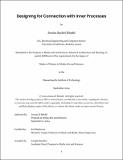Designing for Connection with Inner Processes
Author(s)
Mindel, Jessica Rachel
DownloadThesis PDF (66.65Mb)
Advisor
Machover, Tod
Terms of use
Metadata
Show full item recordAbstract
At a time of division, it is more important than ever that we help each other feel truly understood. Today's online ecosystems offer us many new ways to communicate personal stories, often through fast-paced, reactive channels, but few if any technologies enable us to share what I posit to be a crucial component of how we implicitly understand each other: our inner processes, e.g., how we form our values and identities, navigate unspoken tensions in a community, or feel that something resonates with us.
This thesis explores inner processes as a resource for the design of systems that support human connection, interpersonal understanding, and reflection. Through a series of design iterations, I weigh approaches to eliciting inner processes, choosing media to externally, evocatively represent them, and encouraging perspective-taking behavior by guiding users through each other's inner processes. I approach this topic through three streams of projects, grounded in literatures that outline guidelines for successful perspective-taking and the development of interpersonal closeness, and that assert the value of creative play in surfacing and communicating inner processes, supporting perspective-taking, making room for new social norms, and enabling reframing.
First, I present our collaborative work on Closer Worlds, a two-player, AI-assisted game in which players generate a world they might both want to live in in order to scaffold an emotionally intimate conversation about their memories and shared values. Next, to better understand inner processes entangled with creative practice, I conduct interviews with creative practitioners about the relationships they build through their practice, and design and develop prototypes for implicitly retracing inferred versions of one's own or another person's creative process, capitalizing on room for interpretation. Prototypes include Sjuzet, a compass that anchors the latent space of a user's creative writing to a local map in order to prompt reflection as a user physically wanders through memories, and Pull It Together, a material speculation on textile swatches whose wear and tear modulates to correspond to invisible sociocultural tensions. Finally, I shift my focus to explicitly, informatively trading inner processes in my design of Metaswap, an asynchronous, written activity in which strangers compare annotations about inner processes that arise as they tell personal stories about an uncertainty they are working to resolve in their lives.
Making inner processes explicit and prompting revisitation of them offered both benefits and drawbacks for connection and reflection, but revealed important questions. A mixed-methods analysis across this work presents tensions in the human and machine instinct to make inferences and assumptions about others, and offers opportunities for interpersonally insightful, vulnerable, and trusting conversation when computer-mediated communication and sense-making systems produce deep content rather than deep interactions. Through this work, I hope to lay the foundation for future research on technology's role in supporting interpersonal understanding at a time when so many subjectivities collide and are summarized at the speed of data.
Date issued
2024-09Department
Program in Media Arts and Sciences (Massachusetts Institute of Technology)Publisher
Massachusetts Institute of Technology